The Lancet, Saturday 4 February 1967
PREVALENCE AND PATHOLOGICAL CHANGES OF ISCHAEMIC
HEART-DISEASE IN A HARD-WATER AND IN A SOFT-WATER AREA
T. Crawford
M.D. Glasg., F.R.C.P., F.C.Path
Professor of Pathology, St. George's Hospital Medical School,
London S.W.1
Margaret D. Crawford
M.D. Glasg.
Of the Social Medicine Research Unit of the Medical Research
Council, London Hospital, N.1
Summary
A comparison has been made of cardiac lesions found m a very
soft water area (Glasgow) and in a very hard water area (London)
in two comparable series of medicolegal necropsies--men who had
died from an accident and men who had died suddenly and
unexpectedly from ischaemic heart-disease. In the accident series
the prevalence of myocardial scars (healed infarcts) was greater
in the soft than in the hard water area. At ages 30-44 there was
more atheroma and there were more cases with lumen stenosis in
the soft water area, but at ages 45-69 there was no difference in
the prevalence of extensive atheroma or significant stenosis
between the two areas; only "old occulsion" was commoner in the
Glasgow cases. In the ischaemic-heart-disease series men who had
died in Glasgow had less extensive coronary atheroma and lower
scores for lumen stenosis, age for age, than those who died in
London. The findings in both these series suggest an increased
susceptibility of the myocardium in the soft-water area. Chemical
analysis of the coronary arteries in the accident series
indicated that, at ages under 40 years, there were more men in
the soft-water area with very low values for calcium and
magnesium suggesting content of the arteries is related to the
mineral content of the drinking-water.
Introduction
Associationss have been found between hardness of
drinking-water and mortality from cardiac disease in England and
Wales (Morris, Crawford, and Heady 1961, 1962), in the U.S.A.
(Schroeder 1960), and in Sweden (Biorck et al. 1965)--the softer
the water the higher the mortality-rate from cardiovascular
disease. Despite intensive search for possible confounding
factors, there is no indication so far that hardness of water is
merely reflecting other environmental or social factors. The
possibility remains that there is a causal relationship between
the mineral content of drinking-water and deaths from
cardiovascular disease.
The death-rates in Glasgow for cardiovascular disease,
including arteriosclerotic heart-disease, are about the highest
in Britain and the city has a very soft water-supply: Greater
London has very hard drinking-water and considerably lower
mortality from these causes (table I). We have carried out an
investigation in these two cities to consider these
questions:
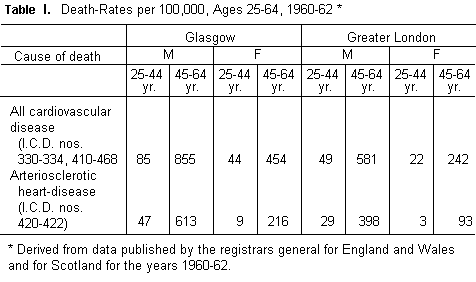
(1) Are the differences in cardiovascular death-rates
reflected in the prevalence of cardiac lesions in the two
populations?
(2) Are there any differences in the pathological features of the
coronary arteries and myocardium in victims of ischaemic
heart-disease in the two areas?
(3) Are there differences in the mineral content of the arteries
related to differences in the mineral content of the
drinking-water in the two areas ?
Material and Methods
Material
We enlisted the aid of pathologists carrying out medicolegal
necropsies in London and Glasgow and compared the cardiac lesions
in two series of cases of "sudden death": male victims of
accidents who died within a short time of the accident and as a
direct result of it (most of the cases in the series were from
road accidents, but a few resulted from industrial accidents and
accidental coal-gas poisoning) and sudden deaths in apparently
healthy men who died before, or shortly after, coming under
medical care and whose deaths were found at necropsy to have been
due to ischaemic heart-disease.
Differences between England and Scotland in medicolegal
procedure were minimised and can be ignored for the purpose of
the study. Cases were as far as possible consecutive, and were
unselected except that after a short time only cases under 60
years were included--thus the age-distribution is not
representative of the whole population.
Information about length of residence in the area was obtained
for most of the cases; 2 accident and 5 ischemic heart-disease
cases were found to have moved from a soft to a hard water area
or vice versa within the previous 10 years and were excluded; for
the majority of the cases there was evidence that they had been
at least 10 years in the same area.
Information about occupation was obtained and each case was
graded in terms of the physical activity of the job (Morris and
Crawford 1958). In the accident series there was no difference in
the proportion of heavy workers between the Glasgow and London
groups, but in the ischemic-heart-disease series there was a
considerably higher proportion of "heavy workers" in the Glasgow
group.
Methods
We were concerned solely with the findings in the heart. All
the hearts were dissected and examined by T.C. who did not know
the origin and other details of the specimens until after the
findings had been recorded and assessments had been made. The
coronary arteries were cut transversely at intervals of 5 mm. or
less, examined under a dissecting microscope, and an assessment
of disease was made in each of the three principal vessels -- the
right coronary artery, the left trunk with anterior descending
branch, and the circumflex artery.
The extent of atherosclerosis was assessed by the
rough quantitative method used in previous studies (Crawford et
al. 1961, Crawford 1966( -- i.e., the length of each of the main
vessels involved by confluent atherosclerosis was measured in
centimetres, and the three figures were combined to give a
numerical assessment of the extent of the disease. This
assessment is clearly only approximate and underestimates the
total extent by neglecting involvement of other branch arteries
and ignoring areas showing only discrete plaques. But it is a
useful index for comparison between groups.
Stenosis was assessed by estimating the area of the
residual lumen and expressing it as a fraction of the original
cross-sectional area of the vessel; thus stenosis to a quarter
implies that the cross-sectional area of the remaining lumen has
been assessed as a quarter of the original lumen. The highest
degree of stenosis in each of the three main arteries was graded
as follows: no stenosis or lumen nowhere less than two-thirds of
normal (0), lumen two-thirds to a third of normal (1), lumen a
third to a quarter of normal (2); or lumen reduced to a quarter
or less (i.e., near complete or complete occlusion) (3). A
stenosis "score" calculated for the three arteries in each case
could, therefore, range from 0 to 9. Reduction of the lumen to a
third or less -- i.e., grades 2 and 3 -- is used as the criterion
of significant stenosis.
Old and recent occlusions were recorded: segments
showing occlusion, or those with maximal stenosis were processed
through paraffin for microscopial confirmation of the findings.
Lesions were regarded as "old occlusions" when the lumen was
plugged with granulation or fibrous tissue or when organisation
had led to the formation of two or more recanalising channels.
Only in such circumstances is it possible to be certain of the
occlusive nature of a lesion, though the probability is that many
eccentric stenoses result from retraction and organisation of
large occluding thrombi. It is likely therefore that the figures
presented underestimate the frequency of old occlusions.
Occlusions were regarded as recent when fibrin and other
components of thrombus still formed a conspicuous part of the
occluding mass; in a few instances atheromatous debris and lipid
formed part of the occluding plug.
The myocardium was inspected for the presence of recent
infarcts, scars, or "healed infarcts" (areas of fibrosis with one
measurement exceeding 1 cm.) and smaller areas of fibrosis.
Finally, the coronary arteries were dissected out and analysed
for calcium and magnesium: the results are given in mg. per 100
g. wet weight.
Results
The number and age-distribution of the cases in each series
are shown in table II.
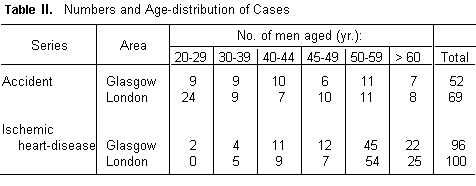
Accident Series
The prevalence of coronary disease and myocardial fibrosis in
the London and Glasgow cases is shown in table III: under 30
years of age disease was minimal in both groups and such cases
are not included in this table. Ages of the two groups remaining
are closely matched (table II). In the younger men, aged 30-44
the average extent of confluent atheroma was greater, and there
was a higher prevalence of stenosis in the Glasgow cases but
numbers are too small for the differences to be statistically
significant. In the older group (45-69 years) the prevalence of
coronary-artery disease was much the same for the two areas, only
the index "old occlusion" had higher figures for Glasgow than for
London. There is, however, a striking difference in the
prevalence of myocardial scarring in the two areas, there being 6
healed infarcts among the Glasgow cases and none among the London
cases. The scars were distributed throughout the age range in the
Glasgow cases and the difference is statistically significant (P
<0.02).
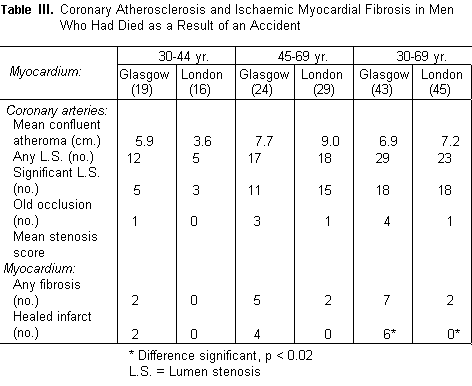
In so far as these accident cases reflect what is happening in
the general population, the findings suggest that there is more
ischemic heart disease in the Glasgow than in the London
population. The known differences in cardiovascular mortality
(table I) are thus reflected in the myocardial lesions; and this
suggests that they are "real" and not merely the result of
differences in diagnostic criteria or certification. Glasgow men
under 45 years had more coronary atheroma and stenosis, but over
45 years the prevalence of coronary-artery disease, as estimated
by the indices used in the present study, was the same in Glasgow
as in London.
Chemical analyses of the coronary arteries were
available for most of the cases under 60 years of age, including
the under-30-year age-group. Tle concentration of calcium in the
coronary arteries increased with age and with the amount of
disease in the arteries, as has been found by others (Lancing
1955, Blanenhorn 1963), disease being the main determinant
because of the precipitation of calcium salts in advanced
lesions. Figs.1 and 2 show the distribution of coronary calcium
and magnesium in the accident cases from the hard and soft water
areas. We had to divide the age-range at 40 instead of 45 in this
analysis because of the amount of disease found in the Glasgow
men at 40- 44 years. Under 40 years of age, when disease is
minimal in both accident series, a greater proportion of the
Glasgow men than of the London men had very low levels of calcium
and magnesium. At ages over 40 and under 60 years, when
coronary-artery disease was more prevalent, the distributions of
the Glasgow and London cases are similar: the calcium
distributions suggest the presence of second peaks. The
distributions of magnesium values in men under 40 show the
greatest differences between Glasgow and London -- of the Glasgow
cases 5 out of 18 had values below 2 mg. while in London only 1
out of 23 had such a low value. Mean values for Glasgow men under
40 years were calcium 39 mg., magnesium 2.8 mg., and for the
London men under 40 years calcium 47 mg., magnesium 4.2 mg. These
findings if confirmed in a larger series, would suggest that the
calcium and magnesium content of drinking-water is of importance
in relation to the concentration of these elements in the
tissues. There seems to be a paradox in the relation of these
minerals and the arterial disease: low tissue concentration of
calcium and magnesium are found in the area where disease appears
earlier and is more lethal, but when disease is established the
minerals are deposited in the lesions and very high values may be
obtained.
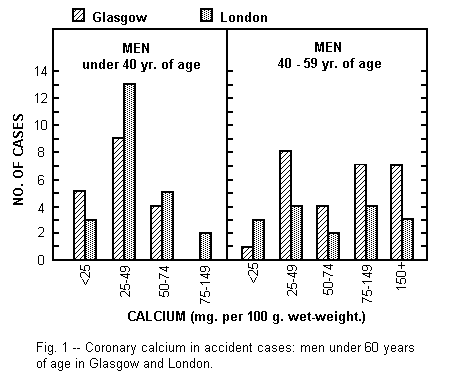
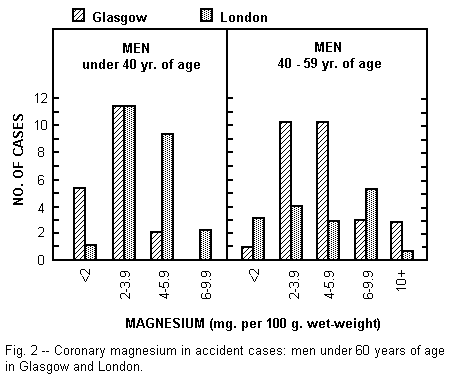
Ischaemic heart-disease Series
Fig. 3 shows the frequency distribution of the extent of
confluent atheroma in the coronary arteries of men from the two
areas -- from under 5 cm. to over 20 cm. involvement. A higher
proportion of the Glasgow cases had limited disease; a third of
the Glasgow cases had less than 15 cm. of disease while only a
sixth of the London cases were in this category. The
age-distribution of the two groups are similar and the difference
found is consistent within each 10-year age-group (p
<0.001).
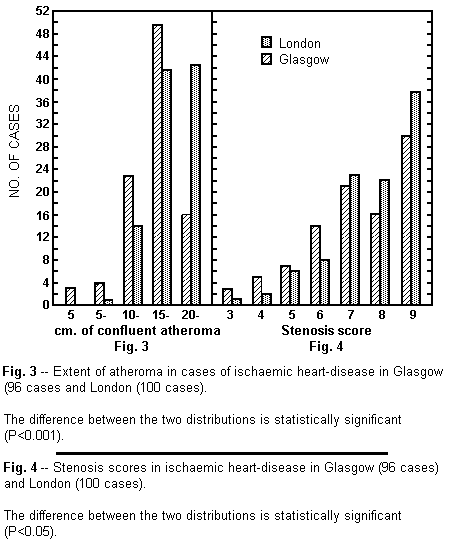
Fig. 4 shows the distribution of stenosis scores. Again, there
a "shift to the right" in the London group indicating more severe
stenosis and more cases with multiple narrowing. The difference
is significant (p <0.05).
Old and recent occlusions and occlusions in more than one
artery were more frequent in the London cases, but the
differences were small and not statistically significant.
In the age-group under 45 years there were more recent
infarcts and myocardial scars (healed infarcts) among the Glasgow
cases than among the London cases, but when all ages are compared
the findings in the myocardium are similar for the two areas.
The chemical findings in the coronary arteries in this series
are dominated by the amount of disease in the coronary arteries;
very high values were obtained for calcium and magnesium in the
majority of cases from both areas. In the age-group under 45
years, however, there were more men with low values for coronary
calcium and magnesium among the Glasgow cases than among the
London cases.
Table IV summarises the differences found between the Glasgow
and London cases at ages under 45. The numbers are too small for
the differences to be statistically significant.
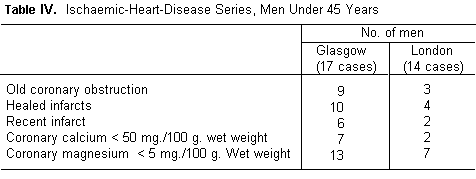
Discussion
Crawford et al. (1961) and Morris and Crawford (1961) found
that in a proportion of men who had died of ischaemic
heart-disease the coronary arteries showed only a limited extent
of disease and that this proportion does not vary much with age.
We have also found this, and it would seem that there are more of
such cases -- i.e., fatal ischaemic heart-disease with only
limited coronary atherosclerosis -- among men who died in a
soft-water area (Glasgow) than among those who died in a
hard-water area (London). The findings in the accident series
seem to be similar, in that there is more ischaemic
heart-disease, as evidenced by myocardial scarring, in the
Glasgow cases without a higher prevalence of coronary
atherosclerosis -- i.e., with the same amount of coronary
atheroma and stenosis, myocardial disease seems more likely to
develop in men in Glasgow than in London. The arterial disease
does appear at an earlier age and there are more old occlusions
in the Glasgow cases.
These findings raise several questions of importance which
cannot be answered with the present limited numbers. For example,
does the disease process develop more rapidly, is the myocardium
more sensitive to minor degrees of ischaemia in Glasgow than in
London? What other factors are involved? The differences cannot
be explained by differences in physical activity: there were more
physically active workers in the Glasgow than in the London
groups so that less ischaemic heart-disease (Morris and Crawford
1958) might have been expected in Glasgow, not more. Different
parts of the spectrum of coronary disease seem to be presenting
in the two areas and there may be an opportunity here to
dissociate "causes" of this multifactorial disease (Morris 1964).
The epidemiological evidence on the distinction between "disease
of the wall" and "disease of the lumen" has been given by Morris
and Crawford (1961). Our findings suggest a third element, and
there may be "causes" related to the myocardial lesion over and
above those involved in the arterial disease.
The finding of an excess of men in the soft-water area with
low values of magnesium in the coronary arteries may be important
in relation to experimental work linking magnesium and myocardial
disease (Vitale et al. 1959, Bajusz 1965, Goldsmith and Goldsmith
1966). The mechanisms for absorption, distribution in the
tissues, and excretion of calcium and magnesium are interrelated
and there is considerable ionic interchange between calcium and
magnesium compounds in intermediary metabolism. In this way
deficiency of one of these elements may affect the associations
of the other. There is evidence that the range of dietary calcium
may be greater than is appreciated; vegetables boiled in soft
water lose an appreciable proportion of their calcium content to
the water, while the calcium content of vegetables boiled in hard
water may be greatly increased through precipitation on their
surfaces from the water (Report of Government Chemist
1963). This could result in less readily available calcium in
soft-water areas with corresponding effects on magnesium
metabolism. In this country the fortification of bread with
calcium makes an absolute dietary deficiency in calcium unlikely,
but the more readily absorbed ionised calcium in drinking-water
may make an important special contribution. An association
between calcium intake and blood-lipid has been reported, and it
has been shown that blood-cholesterol levels can be lowered by
increasing calcium intake (Yacowitz et al. 1965). It is important
to emphasise that the associations found between cardiovascular
mortality and softness of drinking-water are not with ischaemic
heart-disease only, but with all cardiovascular disease,
including cerebrovascular disease; other factors, such as
hypertension, or even a non-specific effect in cardiac failure,
may be involved. We have no information about blood-pressure in
the cases reported but in the accident series the average heart
weight of the Glasgow cases was greater than that of the London
cases and this was true within each 10-year age-group. Population
studies of blood-pressure, blood-lipids, diet, and in particular,
the minerals in the diet are needed in comparable groups in soft
and hard water areas; in particular there is a need for serious
investigation of the problem by chemists to help in the
formulation of hypotheses and guide to further research. Large
numbers of deaths are involved and elucidation of the mechanism
producing the difference between the hard and soft water areas
might be the key to more general problems in cardiovascular
disease.
We thank the many pathologists in Glasgow and London for the
collection of specimens, in particular, Dr. R.D. Teare, Dr. J.A.
Imrie, and Dr. J.M. Cameron; Prof. N.H. Martin who supervised the
chemical analyses; Prof. J.N. Morris, Dr. J.A. Heady, and Dr.
M.R. Alderson for advice; the secretarial staff of the Social
Medicine Research Unit, London Hospital, in particular Mrs. D.
Greystoke; and the Medical Research Council for a grant to cover
expenses. Requests for reprints should be addressed to T.C.
References
Bajusz, E. (1965) Nutritional Aspects of Cardiovascular
Diseases. London.
Biorck, G., Bostrom, H., Widstrom, A. (1965) Acta med.
scand. 178, 239.
Blankenhorn, D.H. (1963) in Evolution of the Atherosclerotic
Plaque (edited by R.J. Jones); p 297. Chicago and London.
Crawford, T. (1966) in Second Symposium on Advanced
Medicine (edited by J.R. Trounce); p 42. London.
Crawford, T., Dexter, D., Teare, R.D. (1961) Lancet,
i, 450.
Goldsmith, N.F., Goldsmith, J.R. (1966) Archs envir.
Hlth., 12, 607.
Lancing, A.I. (1955) inSymposium on Atherosclerosis.
National Academy of Sciences: National Research Council,
publication no. 338, p. 50.
Morris, J.N. (1964) Uses of Epidemiology. Edinburgh.
Morris, J.N., Crawford, M.D. (1958) Br. med. J.
ii, 1485.
Morris, J.N., Crawford, M.D. (1961) Lancet,
i, 47.
Morris, J.N., Crawford, M.D., Heady, J.A. (1961)
ibid. p. 860.
Morris, J.N., Crawford, M.D., Heady, J.A. (1962)
ibid. ii, 506.
Registrar General (1960, 1961, 1962) Statistical Review of
England and Wales; part I, medical tables. H.M. Stationery
Office.
Registrar General for Scotland (1960, 1961, 1962) Annual
Report. Edinburgh.
Report of the Government Chemist (1963) H.M.
Stationery Office.
Schroeder, H.A. (1960) J. Am. med. Ass.
172, 1902.
Vitale, J.J., Hellerstein, E.E., Hegsted, D.M., Nakamura, M.,
Farbman, A. (1959) J. clin. Nutr. 7,
13.
Yocowitz, H., Fleischman, A.I., Bierenbqaum, M.L. (1965)
Br. med. J. i, 1352.
This page was first uploaded to The Magnesium Web Site on June
12, 1996
http://www.mgwater.com/







